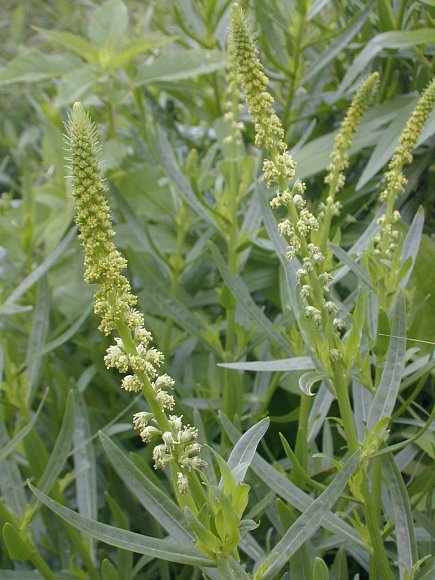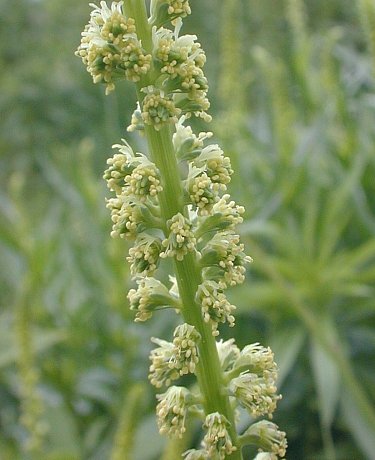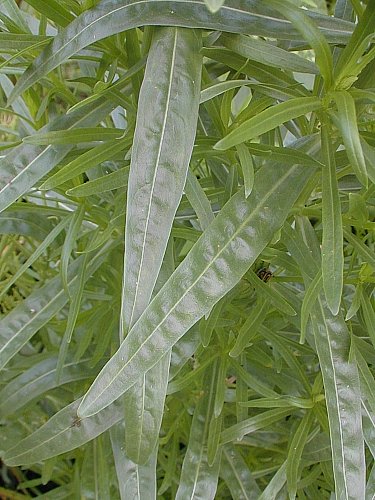Description: This herbaceous biennial plant is 2-5' tall and little branched, except occasionally near the base during the second year. During the first year, this plant consists of a low-growing rosette of basal leaves up to 1' across. These basal leaves are narrowly ovate or oblanceolate and dark green. Their margins are smooth and vertically undulate, sometimes even crinkly-edged, while their upper surface is hairless and shiny. The hairless round stems of plants during the second year have fine longitudinal veins that are dark green. The alternate leaves are up to 5" long and ¾" across, becoming smaller as they ascend the stems. They are narrowly ovate or oblong-linear in shape and more or less sessile against the stems, otherwise their appearance is similar to the basal leaves. The stems terminate in spike-like racemes of yellowish green flowers about ½–2' long. The flowers are densely distributed in all directions along the length of the racemes.

Each flower is ¼"
or less across, consisting of 4 white petals (usually), 3-4 green
sepals, 12-25 stamens with large yellow anthers, and a green capsule in
the middle with 3-4 divided valves. The upper petal is larger than the
lower petals (when they are present) and it has 3-6 slender lobes,
while the lower petals have 3 slender lobes. These lobes provide the
petals with a frilly appearance. There is some variability in the
structure of the flowers, even on the same plant. The blooming period
occurs from late spring to early summer and lasts about 1-2 months. The
3 or 4 valves of the ripened seed capsule become pointed at the top and
split apart, releasing small flattened seeds that are reddish brown and
orbicular-reniform (kidney-shaped, but nearly round). The root system
consists of a stout taproot. This plant spreads by reseeding itself.
Sometimes it forms colonies.
Cultivation:
The preference is full or partial sun, moist to slightly dry
conditions, and soil that contains fertile loam, clay, or coarse
gravelly material. Calcareous soil with a high pH is tolerated.
Second-year plants develop very quickly during the spring and can reach
an impressive size by early summer.

Range &
Habitat:
The non-native Weld is an uncommon plant that rarely naturalizes in the
wild in
Illinois (see Distribution
Map). This is rather surprising considering the robust nature
of the plant. Mohlenbrock (2002) lists this species in Vascular
Flora of Illinois,
but doesn't provide information on state-wide distribution. It was
introduced into the United States from Eurasia. Habitats include weedy
meadows, piles of soil from landscaping or construction activities, and
waste areas with a history of disturbance. Sometimes Weld is grown in
herbal gardens, although it rarely escapes into adjacent areas.
Faunal Association:
According to Müller (1873/1883) in Germany, the flowers are attractive
to bees because they produce abundant nectar and pollen. In particular,
Hylaeus spp. (masked bees) were attracted to the
flowers. Other visitors included honeybees and Andrenid bees. I have
been unable to find any other information about floral-fauna
relationships for this plant.
Photographic Location:
A sunny area in Meadowbrook Park where piles of soil had been
introduced for a landscaping project. The soil in this area was moist
and fertile, and some of the plants were up to 5' tall.

Comments: Weld is a weedy plant that was used in the past as a source for a brilliant yellow dye. It was originally from the Middle East, North Africa, and the Mediterranean area, but has subsequently spread throughout Europe. Weld was harvested by cutting and binding the flowering stalks together after the flowers were nearly finished blooming. Apparently, most of the dye is contained in the seeds. When the dye of Weld is combined with the blue dye of Isatis tinctoria (Woad), the result is a brilliant green dye. Woad is another introduced plant that is sometimes grown in herbal gardens. Members of the Mignonette family have odd-looking flowers that resemble little else. Other members of this family that may escape from cultivation, Reseda alba (Mignonette) and Reseda lutea (Yellow Weed), have pinnately lobed leaves, while the leaves of Weld are never lobed. Mignonette is cultivated primarily for the fragrance of its flowers. Another common name for Weld is Dyer's Rocket, which refers to this plant's use as a dye and its rapid growth during the second year of development.